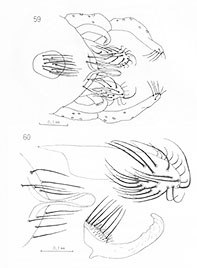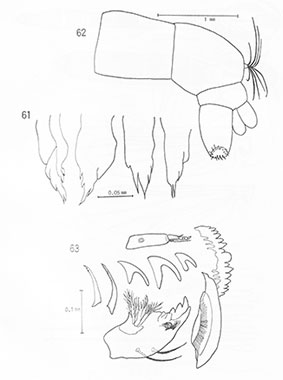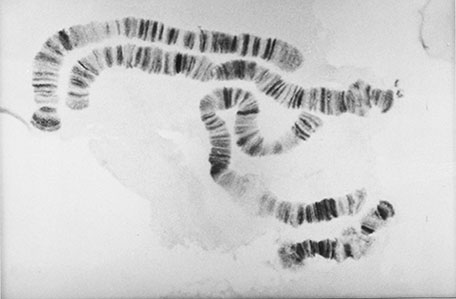C. salinarius (Kieffer 1921)?This species may not be identical to the European and African species (see below) From Sasa (1978): Color almost entirely brown, thoracic scutae hardly visible; legs uniformly dark brown, fore tarsus with long beard. Cross vein of wing conspicuously pigmented. Head: Frontal tubercles 50 x 19 (2.63) µm. Palps (segs. 2-5) 90 : 250 : 250 : 320; P5/P4 & P5/P3 = 1.28. Thoracic setae not listed. Leg lengths (microns) and proportions as follows:
Sasa (1978) compares the coloration to C. acerbiphilus, but notes that it can be distinguished because C. acerbiphilus is shining black.  From Sasa 1978 Wing length 5.4 mm, width 1.35 mm, VR 0.94; body coloration dark as in male. Antennal proportions (micron) 60 : 150 : 110 : 110 : 210. AR 0.49, A5/A1 3.5. Leg lengths (micron) and proportions:
Abdominal tergites almost entirely black, TI-II with inconspicuous apical pale bands. Sasa (1978) compares the coloration to C. acerbiphilus, but notes that it can be distinguished because C. acerbiphilus is shining black. Pupa: Only information is that the spurs of segment VIII have several (1-5) very short but pointed spurs (61, below).  From Sasa 1978 Fourth instar larva: a salinarius-type larva; anal tubules short, less than one-half of the length of the posterior pseudopods (62, above). Length 1 female (14.3 mm), anal tubules short, less than one-half length of the posterior pseudopods. Mentum type I and center tooth type IIA. Gular region pale, frontoclypeus darkened. Four polytene chromosomes possibly with the thummi-group chromosome combination AB, CD, EF, G, although some arms not easy to recognize (Keyl 1962). Nucleolus probably in arm C. Arm G with a large BR about one third from left end (as designated by Keyl & Keyl 1959), another smaller BR near each end. Puff of arm B near distal end. A large subterminal inversion has been recorded in arm E.  Whole chromosome complement of C. salinarius from Bulgaria Found: Japan - Tokushima City; Okunosu, both Tokushima Pref., Shikoku; Lake Toufutsu, Abashiri, and Sorachi River, Kamikawa, Hokkaido; Nakamura, Kochi Prefecture, Shikoku; Noubu, Tsushima Island, Nagasaki Prefecture, Kyushu; Lake Inawashiro, Fukushima Prefecture, Otsu City (35.00°N, 135.88°E), Shiga Prefecture, Honshu. Molecular Data |
Modified: 22 March 20255
Access: Unrestricted
Copyright © 2011-2025, Jon Martin.